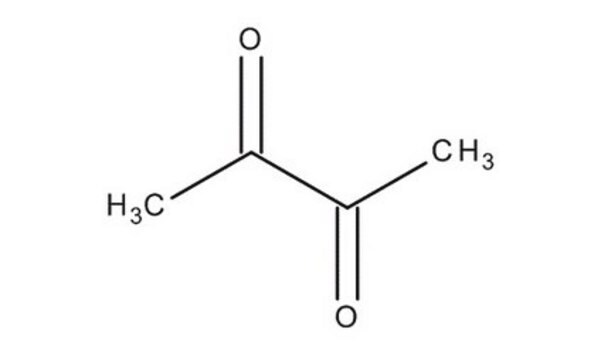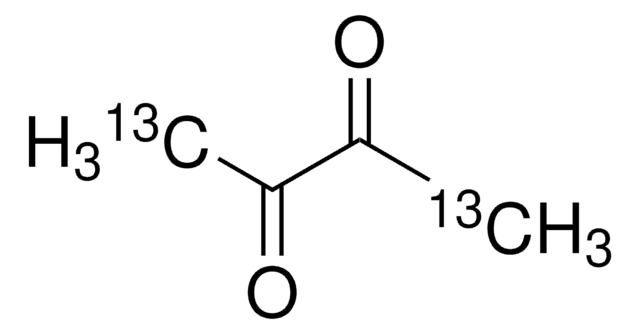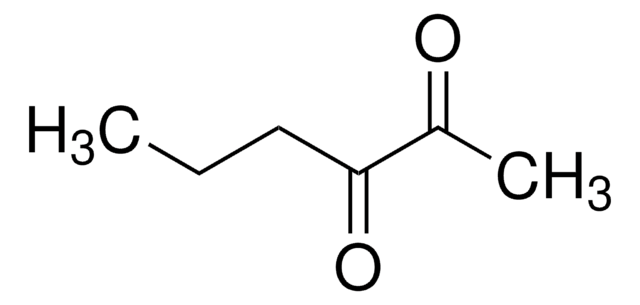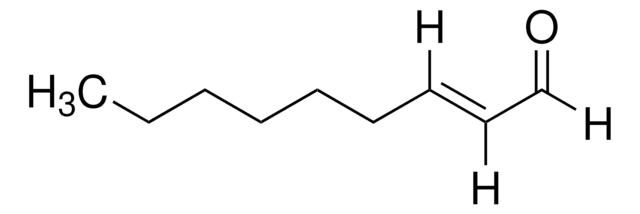Kluczowe dokumenty
11038
2,3-Butanedione
analytical standard
Synonim(y):
Biacetyl, Diacetyl
About This Item
Polecane produkty
klasa czystości
analytical standard
Poziom jakości
gęstość pary
3 (vs air)
ciśnienie pary
52.2 mmHg ( 20 °C)
Próba
≥99.0% (GC)
temp. samozapłonu
345 °C
okres trwałości
limited shelf life, expiry date on the label
metody
HPLC: suitable
gas chromatography (GC): suitable
współczynnik refrakcji
n20/D 1.394 (lit.)
tw
88 °C (lit.)
gęstość
0.981 g/mL (lit.)
Zastosowanie
cleaning products
cosmetics
environmental
flavors and fragrances
food and beverages
personal care
format
neat
ciąg SMILES
CC(=O)C(C)=O
InChI
1S/C4H6O2/c1-3(5)4(2)6/h1-2H3
Klucz InChI
QSJXEFYPDANLFS-UHFFFAOYSA-N
Szukasz podobnych produktów? Odwiedź Przewodnik dotyczący porównywania produktów
Opis ogólny
Zastosowanie
Polecane produkty
Hasło ostrzegawcze
Danger
Zwroty wskazujące rodzaj zagrożenia
Zwroty wskazujące środki ostrożności
Klasyfikacja zagrożeń
Acute Tox. 3 Inhalation - Acute Tox. 4 Oral - Eye Dam. 1 - Flam. Liq. 2 - Skin Irrit. 2 - Skin Sens. 1 - STOT RE 2 Inhalation
Organy docelowe
Respiratory system
Kod klasy składowania
3 - Flammable liquids
Klasa zagrożenia wodnego (WGK)
WGK 2
Temperatura zapłonu (°F)
44.6 °F - closed cup
Temperatura zapłonu (°C)
7 °C - closed cup
Środki ochrony indywidualnej
Eyeshields, Faceshields, Gloves, Heavyweight Gloves, Safety Clothing, type ABEK (EN14387) respirator filter
Wybierz jedną z najnowszych wersji:
Masz już ten produkt?
Dokumenty związane z niedawno zakupionymi produktami zostały zamieszczone w Bibliotece dokumentów.
Klienci oglądali również te produkty
Protokoły
-Cymene; 2,5-Dimethylpyrrole; Acetoin, ≥96%, FCC, FG; 2,5-Dimethylpyrazine; 2,6-Dimethylpyrazine; 2-Ethylpyrazine, ≥98%, FG; 2,3-Dimethylpyrazine; 4-Heptanone; 3-Ethylpyridine; 2,3,5-Trimethylpyrazine; Furfural; Pyrrole; Furfuryl acetate; Linalool; Linalyl acetate; 5-Methylfurfural; γ-Butyrolactone; 2-Acetyl-1-methylpyrrole; Furfuryl alcohol; 2-Acetylpyrrole; Pyrrole-2-carboxaldehyde
Nasz zespół naukowców ma doświadczenie we wszystkich obszarach badań, w tym w naukach przyrodniczych, materiałoznawstwie, syntezie chemicznej, chromatografii, analityce i wielu innych dziedzinach.
Skontaktuj się z zespołem ds. pomocy technicznej














